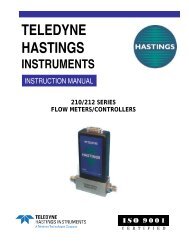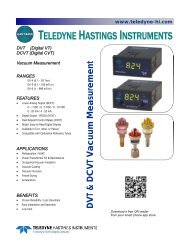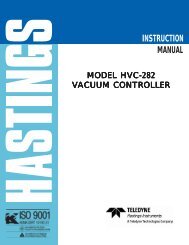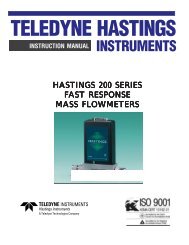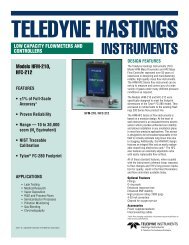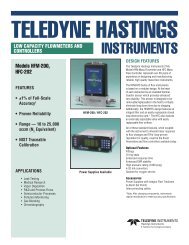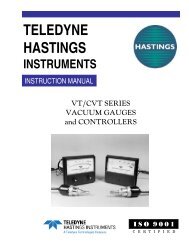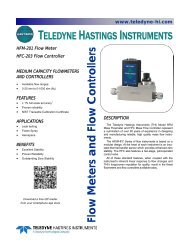HFM-401/405 - Teledyne Hastings Instruments
HFM-401/405 - Teledyne Hastings Instruments
HFM-401/405 - Teledyne Hastings Instruments
You also want an ePaper? Increase the reach of your titles
YUMPU automatically turns print PDFs into web optimized ePapers that Google loves.
1. General Information1. General Information1.1. Overview1.1.1. 400 Series FamilyThe <strong>Hastings</strong> 400 Series is a family of flow instruments which is specifically designed to meet the needsof the industrial gas flow market. The “I” family in the 400 Series features an IP-65 enclosure whichallows the use of the instrument in a wide variety of environments. The 400 I products consist of fourconfigurations: a flow meter, <strong>HFM</strong>-I-<strong>401</strong>, which has a nominal nitrogen full scale between 10 SLM and300 SLM and a corresponding flow controller, the HFC-I-403; a larger flow meter, <strong>HFM</strong>-I-<strong>405</strong>, whichranges from 100 SLM to 2500 SLM, and a corresponding flow controller, the HFC-I-407. Theseinstruments are configured in a convenient in-line flow-through design with standard fittings. Eachinstrument in the series can be driven by either a +24 VDC power supply or a bipolar ±15 volt supply.The electrical connection can be made via either a terminal strip located inside the enclosure oroptionally through an IP-65 compatible electrical connector. Also, these instruments include bothanalog and digital communications capabilities.1.1.2. 400 Series MetersThe <strong>Hastings</strong> <strong>HFM</strong>-I-<strong>401</strong> and <strong>HFM</strong>-I-<strong>405</strong> thermal mass flow meters are designed to provide veryaccurate measurements over a wide range of flow rates and environmental conditions. The design issuch that no damage will occur from moderate overpressure or overflows and no maintenance isrequired under normal operating conditions when using clean gases.1.1.3. Measurement ApproachThe instrument is based on mass flow sensing. This is accomplished by combining a high-speed thermaltransfer sensor with a parallel laminar flow shunt (see Figure 1-1). The flow through the meter is splitbetween the sensor and shunt in a constant ratio set by the full scale range. The thermal sensor consistsof a stainless steel tube with a heater at its center and two thermocouples symmetrically locatedupstream and downstream of the heater. The ends of the sensor tube pass through an aluminum blockand into the stainless steel sensor base. With no flow in the tube the thermocouples report the sameelevated temperature; however a forward flow cools the upstream thermocouple relative to thedownstream. This temperature difference generates a voltage signal in the sensor which is digitized andtransferred to the main processor in the electronics enclosure. The processor uses this real-timeinformation and the sensor/shunt characteristics stored in non-volatile memory to calculate and reportthe flow.To ensure an inherently linear response to flow, both the thermal sensor and the shunt have beenengineered to overcome problems common to other flow meter designs. For example, nonlinearities andperformance variations often arise in typical flow meters due to pressure-related effects at the entranceand exit areas of the laminar flow shunt. <strong>Hastings</strong> has designed the 400 Series meters such that the flowcriticalsplitting occurs at locations safely downstream from the entrance effects and well upstream fromthe exit effects. This vastly improves the stability of the flow ratio between the sensor and shunt. Theresult of this design feature is a better measurement when the specific gravity of the flowing mediumvaries, for instance due to changes in pressure or gas type. Also, a common problem in typical flowmeters is a slow response to flow changes. To improve response time, some flow meter designsintroduce impurities such as silica gel. Alternatively, <strong>Hastings</strong> has designed the 400 Series sensor withreduced thermal mass to improve the response time without exposing additional materials to the gasstream.1.1.4. Additional FunctionsThese instruments contain a number of functions in addition to reporting flow which include:• Settable alarms and warnings with semiconductor switch outputs<strong>401</strong>-<strong>405</strong> SERIES - 1 -



